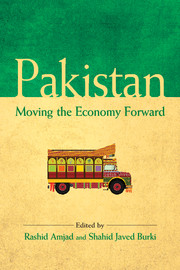Book contents
- Frontmatter
- Contents
- List of figures and tables
- Preface
- 1 Overview
- 2 Failed Economic Promise: Lessons from Pakistan's Development Experience
- 3 Economic Management Under IMF Tutelage: Key Lessons from the Musharraf and PPP Rule 1999–2013
- 4 A Country and an Economy in Transition
- 5 Tackling the Energy Crisis
- 6 Exports: Lessons from the Past and the Way Forward
- 7 The Future Path of Tax Reforms in Pakistan
- 8 Pakistan's Indus Basin Water Strategy: Past, Present and Future
- 9 Economic Governance and Institutional Reforms
- 10 Benefiting from Foreign Direct Investment
- 11 An Analysis of the Remittances Market in Pakistan
- 12 The Prospects for Indo-Pakistan Trade
- 13 Beyond the Poverty Line: A Multidimensional Analysis of Poverty in Pakistan
- 14 Can the New Intergovernmental Structure Work in Pakistan? Learning from China
- Contributors
- Index
11 - An Analysis of the Remittances Market in Pakistan
Published online by Cambridge University Press: 05 May 2015
- Frontmatter
- Contents
- List of figures and tables
- Preface
- 1 Overview
- 2 Failed Economic Promise: Lessons from Pakistan's Development Experience
- 3 Economic Management Under IMF Tutelage: Key Lessons from the Musharraf and PPP Rule 1999–2013
- 4 A Country and an Economy in Transition
- 5 Tackling the Energy Crisis
- 6 Exports: Lessons from the Past and the Way Forward
- 7 The Future Path of Tax Reforms in Pakistan
- 8 Pakistan's Indus Basin Water Strategy: Past, Present and Future
- 9 Economic Governance and Institutional Reforms
- 10 Benefiting from Foreign Direct Investment
- 11 An Analysis of the Remittances Market in Pakistan
- 12 The Prospects for Indo-Pakistan Trade
- 13 Beyond the Poverty Line: A Multidimensional Analysis of Poverty in Pakistan
- 14 Can the New Intergovernmental Structure Work in Pakistan? Learning from China
- Contributors
- Index
Summary
Introduction
Remittances to developing countries sent through official channels were estimated at USD 406 billion in 2012 (World Bank, 2012). This represents a growth of 6.5 per cent over 2011 and is projected to rise by 8 per cent in 2013 and 10 per cent in 2014. Current remittance flows are over three times the amount of official development assistance (World Bank, 2012). In Pakistan, remittances through official channels have grown from just around USD 1.5 billion in 1997/98 to slightly over USD 13 billion in 2011/12 (State Bank of Pakistan, n.d.; see also Table 11.1). In the first six months (July– December 2012), they were slightly over USD 7 billion—an increase of 12 per cent over the corresponding period in the previous year (July–December 2011).
An earlier study (Amjad, Arif, & Irfan, 2012) analyzes the possible reasons for this manifold increase and in its preliminary findings suggests that the increase is primarily due to (i) a shift from unofficial (and unrecorded) channels (hawala) to official channels; (ii) an increase in the number of migrants abroad; and (iii) a rise in migrants' skill levels, resulting in higher wages and incomes abroad. The study also makes the important observation that the inflow of remittances is not just from Pakistani workers abroad but from the larger Pakistani diaspora, many of whom may have acquired nationality of their country of residence. The study also infers that official remittance flows also reflect shifts in the diaspora's savings and assets to their home country.
Amjad et al. (2012) also attempt a rough estimate of the volume of remittances coming through both official and unofficial channels. This is based on estimates of the size of the Pakistani diaspora, as reported by different sources, as well as the average volume of remittances sent, based on recent survey data. The range of these estimates suggests that total remittances could be as high as 180 per cent of official recorded remittances.
- Type
- Chapter
- Information
- PakistanMoving the Economy Forward, pp. 280 - 310Publisher: Cambridge University PressPrint publication year: 2015
- 2
- Cited by



